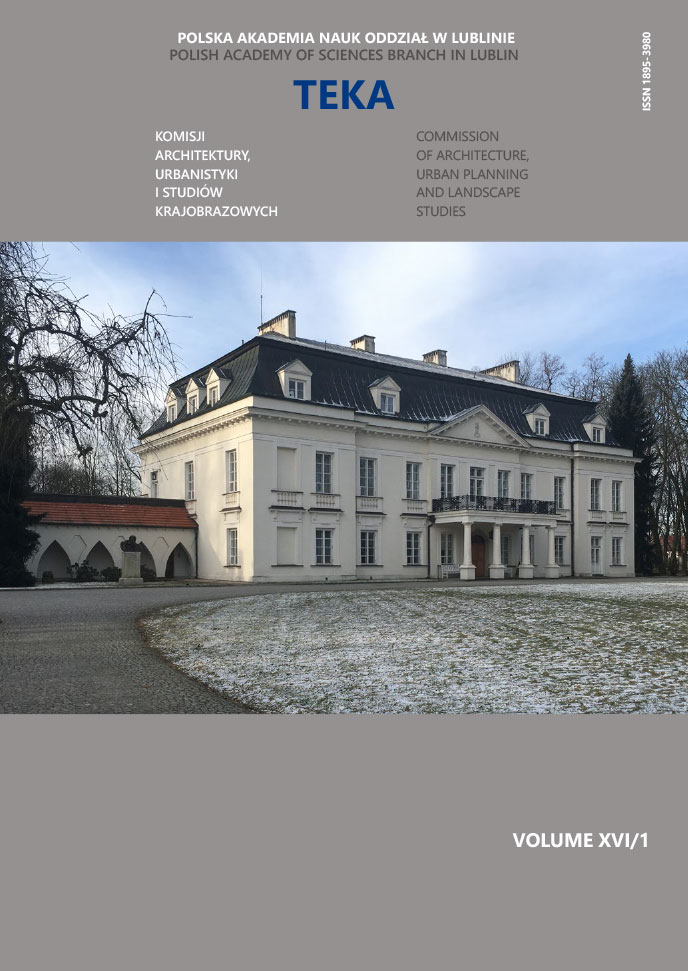Sensory garden in the school area
Article Sidebar
Open full text
Issue Vol. 16 No. 1 (2020)
-
Large format design: full body ceramic tiles and their application in architectural design
Emilia Malec-Zięba7-19
-
Unconventional exhibition spaces as an example of the synergy of architecture and art
Agata Gawlak, Paulina Kowalczyk, Joanna Stefańska20-27
-
Research on painting layers from barracks no. 12 and no. 15 located on the premises of the State Museum at Majdanek
Beata Klimek28-41
-
New York's superslender skyscrapers
Michał Dmitruk42-49
-
This Brzezice Manor House as an example of changing the function of a structure from production to a manor house
Krzysztof Janus50-57
-
Osieczna – development possibilities as a health and SPA resort
Agnieszka Adamska58-70
-
Practical experiences in implementing participatory budgets on examples of selected cities in Poland
Katarzyna Szmygin, Olga Górnik71-78
-
Tactical urbanism or revitalization – a city tailored for the people
Dariusz Gaweł79-86
-
Sensory garden in the school area
Margot Dudkiewicz, Patryk Krupiński, Magdalena Stefanek, Marcin Iwanek87-93
-
Model design of general hospitals in the interwar period on the example of the hospital in Puławy
Natalia Przesmycka94-106
Archives
-
Vol. 18 No. 4
2022-12-30 5
-
Vol. 18 No. 3
2022-12-27 5
-
Vol. 18 No. 2
2022-12-27 5
-
Vol. 18 No. 1
2022-12-27 4
-
Vol. 17 No. 4
2021-12-30 11
-
Vol. 17 No. 3
2021-12-30 9
-
Vol. 17 No. 2
2021-12-30 8
-
Vol. 17 No. 1
2021-12-30 8
-
Vol. 16 No. 4
2020-12-30 11
-
Vol. 16 No. 3
2020-09-30 10
-
Vol. 16 No. 2
2020-06-30 11
-
Vol. 16 No. 1
2020-03-31 10
-
Vol. 15 No. 4
2019-12-30 6
-
Vol. 15 No. 3
2019-10-31 9
-
Vol. 15 No. 2
2019-06-28 12
-
Vol. 15 No. 1
2019-03-29 13
-
Vol. 14 No. 3
2018-10-28 14
-
Vol. 14 No. 2
2018-06-29 14
-
Vol. 14 No. 1
2018-03-30 13
Main Article Content
DOI
Authors
marcin.iwanek@poczta.umcs.lublin.pl
Abstract
School gardens play a huge role in learning about nature by children and young people. Lessons conducted in the open air surrounded by greenery develop the natural interests of students who can observe individual stages of plant development and change of seasons. In school gardens, classes in biological and chemical subjects, art, music, Polish and English can be conducted. The study presents a study of a selected case – a concept of land development at the Primary School in Stasin (Lubelskie Voivodeship) changing the current school environment into a sensory garden. The new project will meet the diverse needs of children, allow them to develop properly mental and physical, and allow teachers to conduct creative classes. The project created zones of the senses, dividing them into the zone of sight, hearing, touch, smell and taste. In addition, a representative zone in front of the building, an educational, sport and recreation zone were distinguished. Consistency of the whole assumption is provided by attractive plantings and unified small architecture.
Keywords:
References
Bańka A. 2002. Społeczna psychologia środowiskowa. WN Scholar, Warszawa.
Choi Y. A., Son K. C. 2000. Development and effect of horticultural therapy program for children. Horticultural therapy for disabled person and children. Korean Horticultural Therapie Association, Seo – Won Books, Seul, Korea.
Dąbski M., Dudkiewicz M. 2010. Przystosowanie ogrodu dla niewidomego użytkownika na przykładzie ogrodów sensorycznych w Bolestraszycach, Bucharzewie i Powsinie. Teka Komisji Architektury, Urbanistyki i Studiów Krajobrazowych PAN oddz. w Lublinie 6: 7−17.
Dudkiewicz M., Pudelska K., Parzymies M., Durlak W. 2018. Rola hortiterapii i bukieciarstwa w leczeniu dzieci i dorosłych. Kosmos 4:813−821. DOI: https://doi.org/10.36921/kos.2018_2418
Etherington N. 2015. Gadrening of children with Autism spectrum Disorders and Special Educational Needs, Jessica Kingsley Publishers, London.
Frątczak E., Frątczak J. 1991. Kącik przyrody w wychowaniu przedszkolnym, Wydawnictwo Szkolne i Pedagogiczne, Warszawa.
Gehl J. 2013. Życie między budynkami. Użytkowanie przestrzeni publicznych. Wydawnictwo RAM, Kraków.
Klichowska A. 2013. Architektura i funkcje ogrodu przedszkolnego w opiniach nauczycieli. Uniwersytet im. Adama Mickiewicza w Poznaniu, Poznań.
Majdecki L. 2008. Historia ogrodów. Wydawnictwo Naukowe PWN, Warszawa
Nowak J. 2003. Rośliny ozdobne – możliwości rozwoju produkcji i oddziaływania na jakość życia. Folia Hortic. Suppl. 1: 29−31.
Pawłowska K. 2008. Ogród sensoryczny. Politechnika Krakowska, Instytut Architektury Krajobrazu, Kraków.
Połucha I., Kruba M. 2012. Możliwości edukacji w przestrzeni ogrodowej. Olsztyn. DOI: https://doi.org/10.35784/teka.2508
Relf P.D. 1981. Therapy and rehabilitation through horticulture. Chronica Horticulturae 21(1): 1−2.
Relf P.D. 1992. Human issue in horticulture. Hort Technology 2(2): 159−171. DOI: https://doi.org/10.21273/HORTTECH.2.2.159
Sobczyńska K. 2014. Zieleń jako element współczesnego miasta i jej rola w przestrzeniach publicznych Poznania, Poznań.
Waliczek T. M., Zajiczek J.M. 1999. Kindergarden: Using computer technology to discover the benefits of children’s gardening, Towards a new millenium in people – plant relationships. Univ.Technol., Sydney, Australia.
Wilson E. O. 1993. Biophilia and the conservative ethic. The biophilia hypothesis, Washington D.C., Island Press, USA.
Article Details
Abstract views: 471
License

This work is licensed under a Creative Commons Attribution-ShareAlike 4.0 International License.


